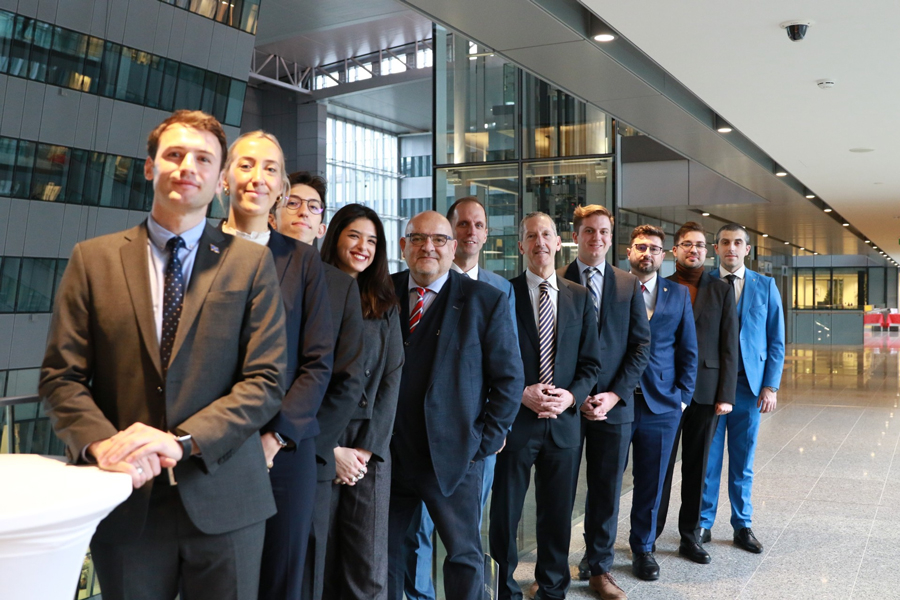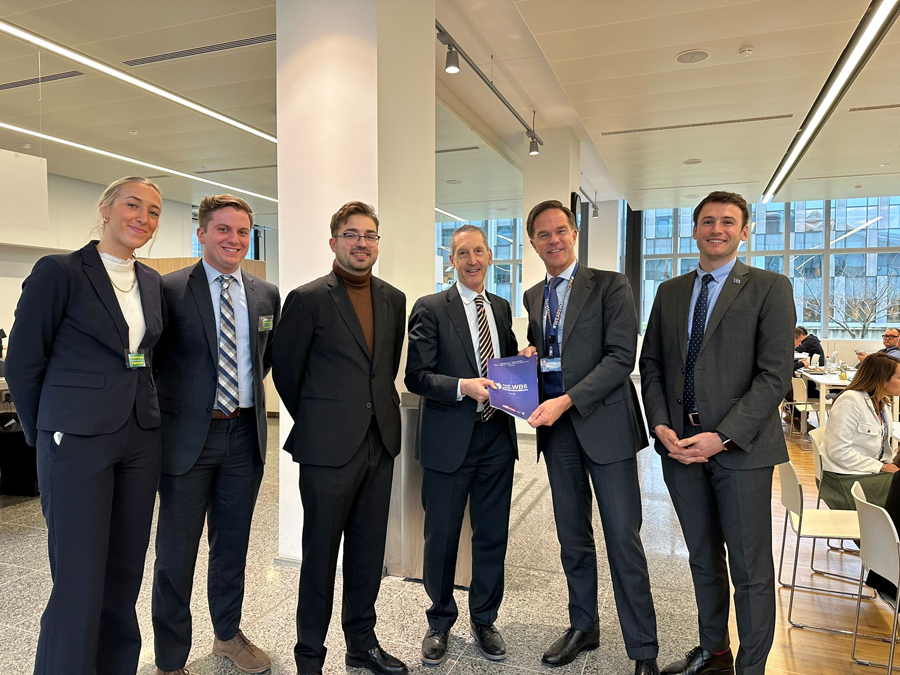SAIS Students and Western Balkans Youth Leaders Brief NATO Officials and Delegations

On December 10, 2024, a day when decision-makers at NATO focused on continuing instability in the Balkans, two SAIS students—together with their youth leader counterparts from across the six key Western Balkans nations—presented their Recommendations Report in person to the Alliance’s highest-level officials, NATO staff and member state delegations.
Invited to NATO headquarters in Brussels by the U.S. Mission to NATO, SAIS student leaders Kaja Burja and Nick Kalams, along with the youth leaders from the Balkans, met Secretary-General Mark Rutte and Deputy Secretary-General, Radmila Sekerinska.
Burja, a second year MAIR student (Bologna, 2024), and Kalams, a 2023 MAIR graduate (Bologna, 2023), have been working for the past year with emerging young experts from the Western Balkans Six (WB6) countries to identify imaginative new ways that NATO can advance progress in the still-troubled Balkans.
The ‘Seeing is Believing’ project, conceived and led by SAIS Adjunct Professor and FPI Senior Fellow Edward P. Joseph, and Dr. Saso Ordanoski of Forum (North Macedonia), is supported by a grant from the U.S. Mission to NATO. Drawing on his experience in the region, including as a U.S. Army officer deployed with IFOR (NATO’s first major crisis response operation), Joseph identified WB6 youth leaders who shared a conviction that the Alliance could do more to stabilize the Balkans. Impressed by the collaboration of SAIS students and their regional counterparts—which bridged ethno-national divides—the U.S. Mission brought the co-directors and youth leaders to NATO headquarters to discuss their recommendations.
“Working successfully with security-focused students and young leaders from all WB6 countries in developing these vital recommendations is a reminder that regional cooperation is possible,” said Burja. “The invitation to present our work to senior officials in NATO is the most rewarding experience of my career so far.”
Kalams noted: “Participating in the development of serious policy proposals and then presenting and discussing them with NATO officials and diplomats has been an incredible learning experience.”

The discussion with just-appointed Deputy Secretary General Sekerinska was particularly substantive and enlightening. In September, Sekerinska, who previously served as North Macedonia’s defense minister, joined Professors Joseph and Ordanoski at a public event in Skopje focusing on the Recommendations Report. It was clear that Sekerinska had thoroughly studied the report and, like NATO staff and diplomats, was impressed by the work.
The working visit to NATO headquarters represents a switch from the traditional study visit. As Professor Joseph recalled, “When I was a SAIS student in Bologna, the school organized a trip to NATO where students received briefings. I was determined to flip the script and allow Kaja and Nick and their WB6 colleagues to brief NATO officials—in addition to receiving briefings.”
Several officials expressed active interest in plausible new ideas to stabilize the region. And with good reason. On the very same day as the SAIS/Youth Leaders visit, EU Special Balkans Representative Miroslav Lajcak briefed the North Atlantic Council on the troubling situation between Kosovo and Serbia.
Joining Burja and Kalams at NATO headquarters were the WB6 youth leader coordinators: Redion Qirazi (Albania); Zeljko Vuksa-Fejzic (Bosnia-Herzegovina); Bajram Geci (Kosovo); Sofija Kirsanov (Montenegro); Flamur Hamidi (North Macedonia); and Stefan Boskovic (Serbia). In their home countries, these youth leaders worked with a diverse group of security-minded young colleagues, each of whom recognizes the potential of the Alliance to do more.
“This visit to NATO proved the role SAIS students can play even while enrolled,” Professor Joseph stated. “There is no question that NATO staff and delegations looked upon Kaja and Nick and their colleagues as emerging experts, perhaps opening the door to further opportunities. Whether NATO acts on the recommendations or not, the ‘Seeing is Believing’ project and this visit have already paid dividends.”
Enjoyed reading about SAIS Students and Western Balkans Youth Leaders Brief NATO Officials and Delegations? Explore all that our Washington D.C. campus has to offer.